中国历史和中国地理
中国地理、历史顺口溜
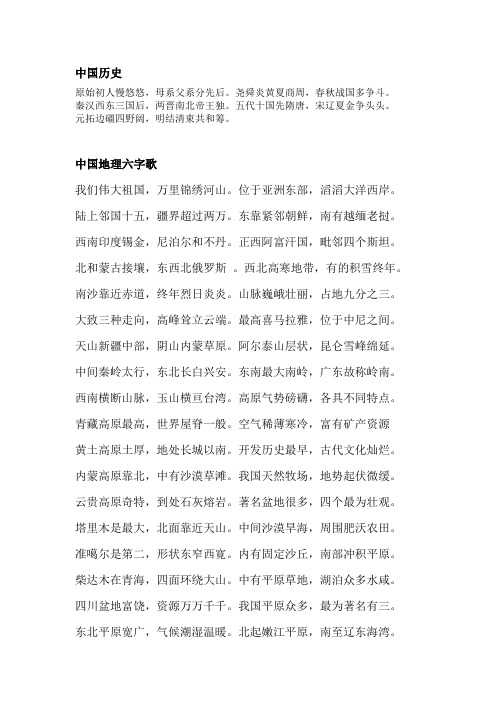
中国历史原始初人慢悠悠,母系父系分先后。
尧舜炎黄夏商周,春秋战国多争斗。
秦汉西东三国后,两晋南北帝王独。
五代十国先隋唐,宋辽夏金争头头。
元拓边礓四野阔,明结清束共和筹。
中国地理六字歌我们伟大祖国,万里锦绣河山。
位于亚洲东部,滔滔大洋西岸。
陆上邻国十五,疆界超过两万。
东靠紧邻朝鲜,南有越缅老挝。
西南印度锡金,尼泊尔和不丹。
正西阿富汗国,毗邻四个斯坦。
北和蒙古接壤,东西北俄罗斯。
西北高寒地带,有的积雪终年。
南沙靠近赤道,终年烈日炎炎。
山脉巍峨壮丽,占地九分之三。
大致三种走向,高峰耸立云端。
最高喜马拉雅,位于中尼之间。
天山新疆中部,阴山内蒙草原。
阿尔泰山层状,昆仑雪峰绵延。
中间秦岭太行,东北长白兴安。
东南最大南岭,广东故称岭南。
西南横断山脉,玉山横亘台湾。
高原气势磅礴,各具不同特点。
青藏高原最高,世界屋脊一般。
空气稀薄寒冷,富有矿产资源黄土高原土厚,地处长城以南。
开发历史最早,古代文化灿烂。
内蒙高原靠北,中有沙漠草滩。
我国天然牧场,地势起伏微缓。
云贵高原奇特,到处石灰熔岩。
著名盆地很多,四个最为壮观。
塔里木是最大,北面靠近天山。
中间沙漠旱海,周围肥沃农田。
准噶尔是第二,形状东窄西寛。
内有固定沙丘,南部冲积平原。
柴达木在青海,四面环绕大山。
中有平原草地,湖泊众多水咸。
四川盆地富饶,资源万万千千。
我国平原众多,最为著名有三。
东北平原宽广,气候潮湿温暖。
北起嫩江平原,南至辽东海湾。
重要粮食基地,发展前途无限。
华北平原居中,雨足肥沃平坦。
大部冲积黄土,盛产棉麦油烟。
长江中游下游,一片冲积平原。
素称鱼米之乡,更产茶麻桑蚕。
我国濒临四海,海水白浪滔天。
最北称作渤海,两大半岛之间。
海水深入内陆,面积最小水浅。
渤海口外黄海,南至长江口岸。
东海南至厦门,北与黄海相连。
曾母暗沙以北,台湾海峡以南。
是为我国南海,海域面积最宽。
中西航行要道,海洋浑然一片。
四海紧靠大陆,海岸曲曲弯弯。
北起鸭绿江口,南到北仑河边。
沿岸沙岩相连,南北遍布海湾。
中国文化生息繁衍的地理环境
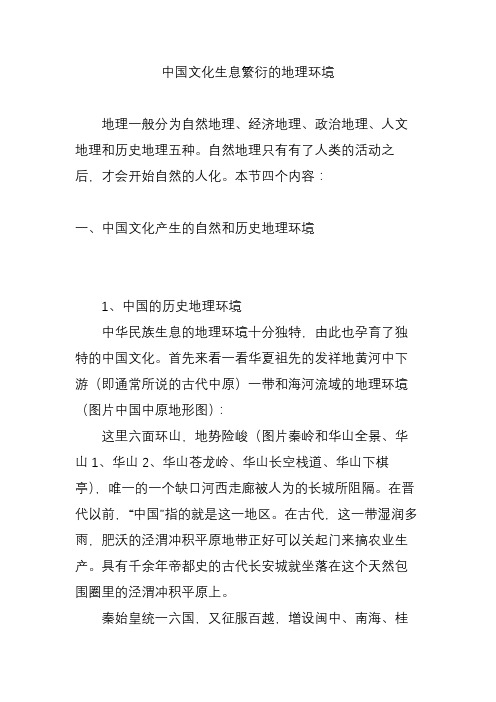
中国文化生息繁衍的地理环境地理一般分为自然地理、经济地理、政治地理、人文地理和历史地理五种。
自然地理只有有了人类的活动之后,才会开始自然的人化。
本节四个内容:一、中国文化产生的自然和历史地理环境1、中国的历史地理环境中华民族生息的地理环境十分独特,由此也孕育了独特的中国文化。
首先来看一看华夏祖先的发祥地黄河中下游(即通常所说的古代中原)一带和海河流域的地理环境(图片中国中原地形图):这里六面环山,地势险峻(图片秦岭和华山全景、华山1、华山2、华山苍龙岭、华山长空栈道、华山下棋亭),唯一的一个缺口河西走廊被人为的长城所阻隔。
在晋代以前,“中国”指的就是这一地区。
在古代,这一带湿润多雨,肥沃的泾渭冲积平原地带正好可以关起门来搞农业生产。
具有千余年帝都史的古代长安城就坐落在这个天然包围圈里的泾渭冲积平原上。
秦始皇统一六国,又征服百越,增设闽中、南海、桂林、象郡四郡,疆域北起河套、阴山山脉和辽河下游,南至今越南北部和两广,西至陇山、川西和云贵高原,东到大海,奠定了中国版图的基本规模。
西汉时期,匈奴呼韩邪单于降汉,标志着控制漠北广大领域的匈奴已成为汉朝藩属。
张骞通使西域,设西域都护府,西部疆域扩展到今天新疆的大部分地区;又争取乌桓(今天辽宁一带)归汉,设立乌桓校尉;还开发西南夷,闽、粤、黔、滇都设置了郡县。
此后,中国历代王朝的疆域虽然时有盈缩(唐宋元明清的版图比现在要大得多,图片唐朝前期形势图),但基本趋势是逐渐扩大,不断巩固。
元代时,西藏正式成为中国版图。
明代时,经郑成功收复,台湾回到祖国的怀抱。
至清朝时,除了鸦片战争后被俄帝国攫取的北部和西北部大片领土外,今天中国960万平方公里的土地已经确定。
2、中国的自然地理环境(图片中国地形图)中国地理环境的总体特征是:地域辽阔,地势地形复杂,古今地貌稳中有变,气候南北差异明显,四周天然障碍大,环境恶劣。
(1)四周环境:周边四至,东面是浩瀚大洋,北面是漫漫戈壁沙漠,西面是雪山高原,南面是崇山峻岭。
中国地理人文知识大全

中国地理人文知识大全中国地理和人文知识非常广泛,包含地理位置、自然地理、历史、文化、人口、经济等多个方面。
以下是一个简要的中国地理人文知识概览:1.地理位置:中国位于亚洲东部,东临太平洋,西濒帕米尔高原、喜马拉雅山脉,南隔南海与东南亚相望。
2.自然地理:山脉:北方有阴山、大兴安岭,南方有秦岭、南岭。
藏南有喜马拉雅山脉。
河流:长江,是亚洲第一长河。
黄河,是中国第二长河。
湖泊:长白山下的长白山天池。
云南省的滇池。
3.历史:古代文明:先秦时期的诸子百家、春秋战国时期的兵法家。
秦朝统一六国,汉朝的丝绸之路。
封建时代:唐朝的繁荣文化,宋朝的科技进步。
明清时期的大航海时代。
现代历史:辛亥革命,结束封建君主制。
1949年中华人民共和国成立。
4.文化:语言:汉语是官方语言,有多种方言。
传统艺术:京剧、豫剧、评剧等戏曲形式。
国画、书法、篆刻等传统绘画艺术。
人口:人口分布:东部沿海地区人口密集,西部和北部人口相对较少。
少数民族:汉族是主体,还有五十多个少数民族,如维吾尔族、藏族、蒙古族等。
5.经济:改革开放:1978年开始的改革开放政策,带动了中国经济的迅速发展。
工业与农业:中国是世界最大的制造业国家。
农业以水稻、小麦等为主。
环境:环境问题:空气和水质污染是现代中国面临的环境问题。
教育:教育体制:九年义务教育,高等教育日益发展。
中国地理历史概况
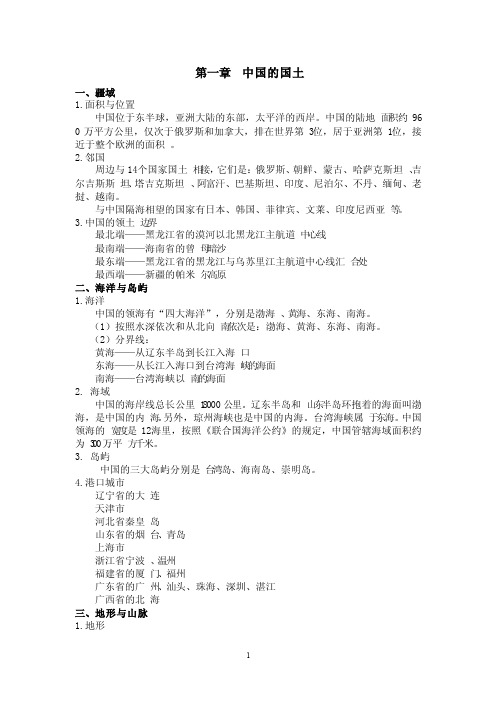
第一章中国的国土一、疆域1.面积与位置中国位于东半球,亚洲大陆的东部,太平洋的西岸。
中国的陆地面积约960万平方公里,仅次于俄罗斯和加拿大,排在世界第3位,居于亚洲第1位,接近于整个欧洲的面积。
2.邻国周边与14个国家国土相接,它们是:俄罗斯、朝鲜、蒙古、哈萨克斯坦、吉尔吉斯斯坦、塔吉克斯坦、阿富汗、巴基斯坦、印度、尼泊尔、不丹、缅甸、老挝、越南。
与中国隔海相望的国家有日本、韩国、菲律宾、文莱、印度尼西亚等。
3.中国的领土边界最北端——黑龙江省的漠河以北黑龙江主航道中心线最南端——海南省的曾母暗沙最东端——黑龙江省的黑龙江与乌苏里江主航道中心线汇合处最西端——新疆的帕米尔高原二、海洋与岛屿1.海洋中国的领海有“四大海洋”,分别是渤海、黄海、东海、南海。
(1)按照水深依次和从北向南依次是:渤海、黄海、东海、南海。
(2)分界线:黄海——从辽东半岛到长江入海口东海——从长江入海口到台湾海峡的海面南海——台湾海峡以南的海面2. 海域中国的海岸线总长公里18000公里。
辽东半岛和山东半岛环抱着的海面叫渤海,是中国的内海。
另外,琼州海峡也是中国的内海。
台湾海峡属于东海。
中国领海的宽度是12海里,按照《联合国海洋公约》的规定,中国管辖海域面积约为300万平方千米。
3. 岛屿中国的三大岛屿分别是台湾岛、海南岛、崇明岛。
4.港口城市辽宁省的大连天津市河北省秦皇岛山东省的烟台、青岛上海市浙江省宁波、温州福建省的厦门、福州广东省的广州、汕头、珠海、深圳、湛江广西省的北海三、地形与山脉1.地形中国地形的突出特点是:西高东低,复杂多样,呈“阶梯状”分布。
2. 大陆地形的四个阶梯:①第一个阶梯,即西南部的青藏高原,平均海拔4000米以上,被称为“世界屋脊”,地势高,气候寒冷。
口译中国地理与历史简介英文
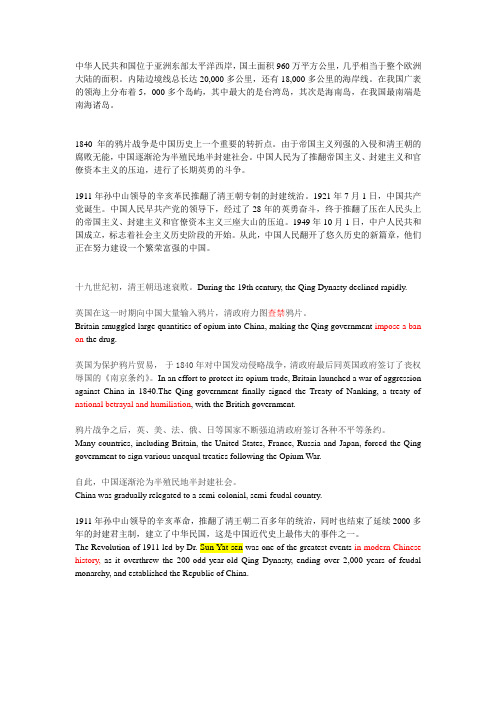
中华人民共和国位于亚洲东部太平洋西岸,国土面积960万平方公里,几乎相当于整个欧洲大陆的面积。
内陆边境线总长达20,000多公里,还有18,000多公里的海岸线。
在我国广袤的领海上分布着5,000多个岛屿,其中最大的是台湾岛,其次是海南岛,在我国最南端是南海诸岛。
1840年的鸦片战争是中国历史上一个重要的转折点。
由于帝国主义列强的入侵和清王朝的腐败无能,中国逐渐沦为半殖民地半封建社会。
中国人民为了推翻帝国主义、封建主义和官僚资本主义的压迫,进行了长期英勇的斗争。
1911年孙中山领导的辛亥革民推翻了清王朝专制的封建统治。
1921年7月1日,中国共产党诞生。
中国人民早共产党的领导下,经过了28年的英勇奋斗,终于推翻了压在人民头上的帝国主义、封建主义和官僚资本主义三座大山的压迫。
1949年10月1日,中户人民共和国成立,标志着社会主义历史阶段的开始。
从此,中国人民翻开了悠久历史的新篇章,他们正在努力建设一个繁荣富强的中国。
十九世纪初,清王朝迅速衰败。
During the 19th century, the Qing Dynasty declined rapidly.英国在这一时期向中国大量输入鸦片,清政府力图查禁鸦片。
Britain smuggled large quantities of opium into China, making the Qing government impose a ban on the drug.英国为保护鸦片贸易,于1840年对中国发动侵略战争,清政府最后同英国政府签订了丧权辱国的《南京条约》。
In an effort to protect its opium trade, Britain launched a war of aggression against China in 1840.The Qing government finally signed the Treaty of Nanking, a treaty of national betrayal and humiliation, with the British government.鸦片战争之后,英、美、法、俄、日等国家不断强迫清政府签订各种不平等条约。
中国历史与地理
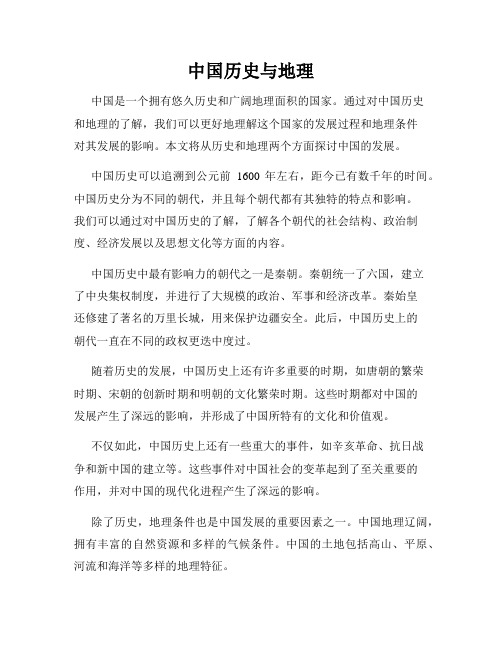
中国历史与地理中国是一个拥有悠久历史和广阔地理面积的国家。
通过对中国历史和地理的了解,我们可以更好地理解这个国家的发展过程和地理条件对其发展的影响。
本文将从历史和地理两个方面探讨中国的发展。
中国历史可以追溯到公元前1600年左右,距今已有数千年的时间。
中国历史分为不同的朝代,并且每个朝代都有其独特的特点和影响。
我们可以通过对中国历史的了解,了解各个朝代的社会结构、政治制度、经济发展以及思想文化等方面的内容。
中国历史中最有影响力的朝代之一是秦朝。
秦朝统一了六国,建立了中央集权制度,并进行了大规模的政治、军事和经济改革。
秦始皇还修建了著名的万里长城,用来保护边疆安全。
此后,中国历史上的朝代一直在不同的政权更迭中度过。
随着历史的发展,中国历史上还有许多重要的时期,如唐朝的繁荣时期、宋朝的创新时期和明朝的文化繁荣时期。
这些时期都对中国的发展产生了深远的影响,并形成了中国所特有的文化和价值观。
不仅如此,中国历史上还有一些重大的事件,如辛亥革命、抗日战争和新中国的建立等。
这些事件对中国社会的变革起到了至关重要的作用,并对中国的现代化进程产生了深远的影响。
除了历史,地理条件也是中国发展的重要因素之一。
中国地理辽阔,拥有丰富的自然资源和多样的气候条件。
中国的土地包括高山、平原、河流和海洋等多样的地理特征。
中国地理中最重要的特征之一是长江和黄河。
长江是中国最长的河流,它穿过中国南部,流经一些重要的城市,如上海和重庆。
黄河是中国第二长河流,它自古以来一直是中国文明的发源地之一,也被誉为中国的“母亲河”。
中国的地理多样性也使得中国拥有丰富的自然资源。
中国拥有世界上最大的稀土资源储量,这对于现代工业的发展至关重要。
此外,中国还拥有大量的煤炭、石油、天然气和水力资源等。
这些自然资源的存在为中国的经济发展提供了有力的支持。
中国的地理条件也对其经济和文化发展产生了重要的影响。
例如,中国的沿海地区是经济发展的重要地区,拥有许多繁忙的港口和经济特区。
中国地理书籍
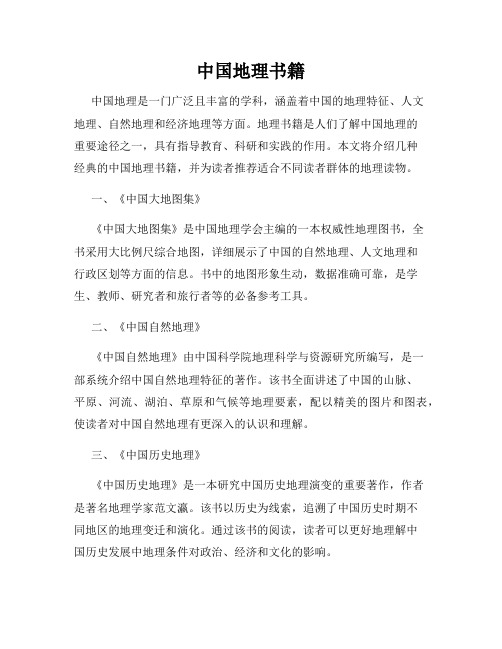
中国地理书籍中国地理是一门广泛且丰富的学科,涵盖着中国的地理特征、人文地理、自然地理和经济地理等方面。
地理书籍是人们了解中国地理的重要途径之一,具有指导教育、科研和实践的作用。
本文将介绍几种经典的中国地理书籍,并为读者推荐适合不同读者群体的地理读物。
一、《中国大地图集》《中国大地图集》是中国地理学会主编的一本权威性地理图书,全书采用大比例尺综合地图,详细展示了中国的自然地理、人文地理和行政区划等方面的信息。
书中的地图形象生动,数据准确可靠,是学生、教师、研究者和旅行者等的必备参考工具。
二、《中国自然地理》《中国自然地理》由中国科学院地理科学与资源研究所编写,是一部系统介绍中国自然地理特征的著作。
该书全面讲述了中国的山脉、平原、河流、湖泊、草原和气候等地理要素,配以精美的图片和图表,使读者对中国自然地理有更深入的认识和理解。
三、《中国历史地理》《中国历史地理》是一本研究中国历史地理演变的重要著作,作者是著名地理学家范文瀛。
该书以历史为线索,追溯了中国历史时期不同地区的地理变迁和演化。
通过该书的阅读,读者可以更好地理解中国历史发展中地理条件对政治、经济和文化的影响。
四、《中国城市地理》《中国城市地理》是一本研究中国城市发展的地理学著作,作者是陈伯祥教授。
该书系统介绍了中国各大城市的起源、发展、布局和特色,对城市化进程进行了深入分析。
读者通过阅读该书,可以了解中国城市空间结构的差异和城市化对社会经济发展的推动作用。
五、《中国经济地理》《中国经济地理》是一本专注于研究中国经济地理问题的著作,作者是中国科学院地理科学与资源研究所的学者们。
该书系统地论述了中国不同地区经济的特点、产业布局和区域发展差异,为读者提供了对中国经济地理的深入认识和全面把握。
六、适合不同读者群体的地理读物推荐对于初学者和中学生,推荐阅读《中国地理通史》、《中国地理概要》等教材类地理书籍。
这类书籍通俗易懂,内容浅显,适合初学者对中国地理基本概念的了解。
中国地理历史概括,中国地理知识大全!
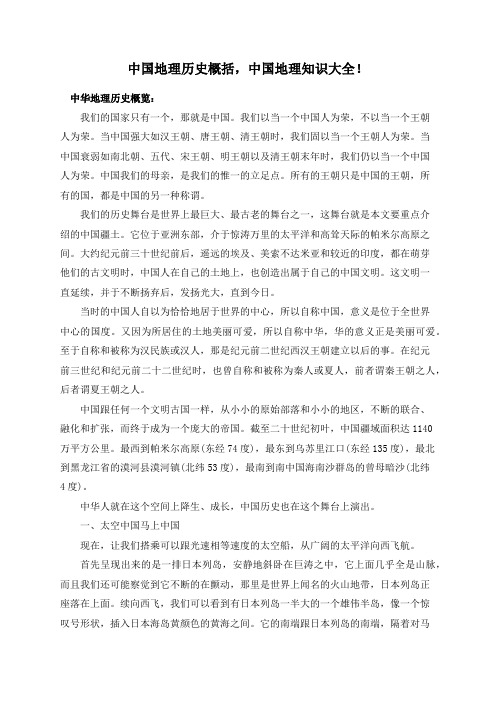
中国地理历史概括,中国地理知识大全!中华地理历史概览:我们的国家只有一个,那就是中国。
我们以当一个中国人为荣,不以当一个王朝人为荣。
当中国强大如汉王朝、唐王朝、清王朝时,我们固以当一个王朝人为荣。
当中国衰弱如南北朝、五代、宋王朝、明王朝以及清王朝末年时,我们仍以当一个中国人为荣。
中国我们的母亲,是我们的惟一的立足点。
所有的王朝只是中国的王朝,所有的国,都是中国的另一种称谓。
我们的历史舞台是世界上最巨大、最古老的舞台之一,这舞台就是本文要重点介绍的中国疆土。
它位于亚洲东部,介于惊涛万里的太平洋和高耸天际的帕米尔高原之间。
大约纪元前三十世纪前后,遥远的埃及、美索不达米亚和较近的印度,都在萌芽他们的古文明时,中国人在自己的土地上,也创造出属于自己的中国文明。
这文明一直延续,并于不断扬弃后,发扬光大,直到今日。
当时的中国人自以为恰恰地居于世界的中心,所以自称中国,意义是位于全世界中心的国度。
又因为所居住的土地美丽可爱,所以自称中华,华的意义正是美丽可爱。
至于自称和被称为汉民族或汉人,那是纪元前二世纪西汉王朝建立以后的事。
在纪元前三世纪和纪元前二十二世纪时,也曾自称和被称为秦人或夏人,前者谓秦王朝之人,后者谓夏王朝之人。
中国跟任何一个文明古国一样,从小小的原始部落和小小的地区,不断的联合、融化和扩张,而终于成为一个庞大的帝国。
截至二十世纪初叶,中国疆域面积达1140万平方公里。
最西到帕米尔高原(东经74度),最东到乌苏里江口(东经135度),最北到黑龙江省的漠河县漠河镇(北纬53度),最南到南中国海南沙群岛的曾母暗沙(北纬4度)。
中华人就在这个空间上降生、成长,中国历史也在这个舞台上演出。
一、太空中国马上中国现在,让我们搭乘可以跟光速相等速度的太空船,从广阔的太平洋向西飞航。
首先呈现出来的是一排日本列岛,安静地斜卧在巨涛之中,它上面几乎全是山脉,而且我们还可能察觉到它不断的在颤动,那里是世界上闻名的火山地带,日本列岛正座落在上面。
中国疆域知识点总结
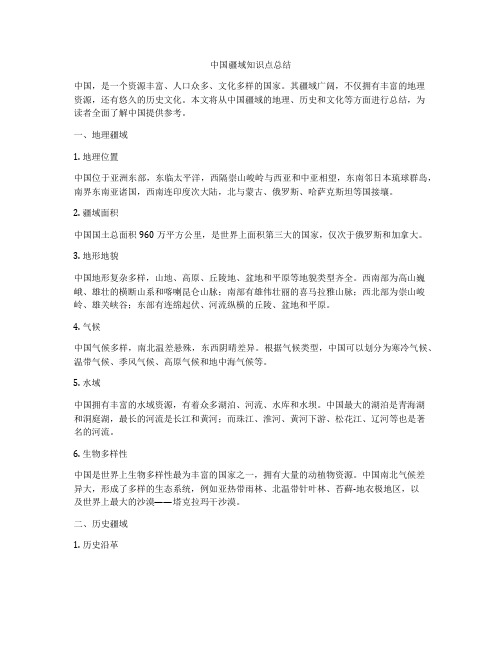
中国疆域知识点总结中国,是一个资源丰富、人口众多、文化多样的国家。
其疆域广阔,不仅拥有丰富的地理资源,还有悠久的历史文化。
本文将从中国疆域的地理、历史和文化等方面进行总结,为读者全面了解中国提供参考。
一、地理疆域1. 地理位置中国位于亚洲东部,东临太平洋,西隔崇山峻岭与西亚和中亚相望,东南邻日本琉球群岛,南界东南亚诸国,西南连印度次大陆,北与蒙古、俄罗斯、哈萨克斯坦等国接壤。
2. 疆域面积中国国土总面积960万平方公里,是世界上面积第三大的国家,仅次于俄罗斯和加拿大。
3. 地形地貌中国地形复杂多样,山地、高原、丘陵地、盆地和平原等地貌类型齐全。
西南部为高山巍峨、雄壮的横断山系和喀喇昆仑山脉;南部有雄伟壮丽的喜马拉雅山脉;西北部为崇山峻岭、雄关峡谷;东部有连绵起伏、河流纵横的丘陵、盆地和平原。
4. 气候中国气候多样,南北温差悬殊,东西阴晴差异。
根据气候类型,中国可以划分为寒冷气候、温带气候、季风气候、高原气候和地中海气候等。
5. 水域中国拥有丰富的水域资源,有着众多湖泊、河流、水库和水坝。
中国最大的湖泊是青海湖和洞庭湖,最长的河流是长江和黄河;而珠江、淮河、黄河下游、松花江、辽河等也是著名的河流。
6. 生物多样性中国是世界上生物多样性最为丰富的国家之一,拥有大量的动植物资源。
中国南北气候差异大,形成了多样的生态系统,例如亚热带雨林、北温带针叶林、苔藓-地衣极地区,以及世界上最大的沙漠——塔克拉玛干沙漠。
二、历史疆域1. 历史沿革中国是一个拥有5000多年文明史的古老国家,其历史悠久、文化灿烂。
中国古代历史分成先秦、秦汉、三国、两晋、南北朝、隋唐、宋元明清等时期,每个时期都有其独特的政治、经济、文化发展。
2. 疆域扩张中国古代通过战争、外交和争夺等手段不断扩张疆域。
自夏朝至清朝,中国的疆域逐渐扩大,形成了辽阔的国土。
3. 疆域变迁中国的疆域变迁是一个复杂的过程,在不同历史时期,中国疆域的范围和形态不断变化。
中国地理环境与历史演变
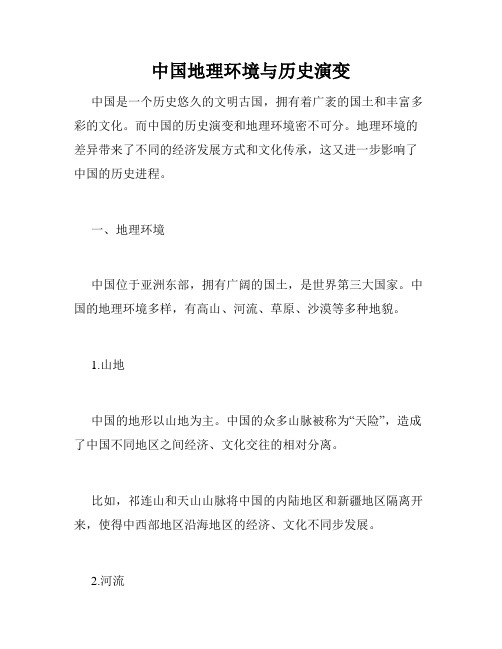
中国地理环境与历史演变中国是一个历史悠久的文明古国,拥有着广袤的国土和丰富多彩的文化。
而中国的历史演变和地理环境密不可分。
地理环境的差异带来了不同的经济发展方式和文化传承,这又进一步影响了中国的历史进程。
一、地理环境中国位于亚洲东部,拥有广阔的国土,是世界第三大国家。
中国的地理环境多样,有高山、河流、草原、沙漠等多种地貌。
1.山地中国的地形以山地为主。
中国的众多山脉被称为“天险”,造成了中国不同地区之间经济、文化交往的相对分离。
比如,祁连山和天山山脉将中国的内陆地区和新疆地区隔离开来,使得中西部地区沿海地区的经济、文化不同步发展。
2.河流中国有长江、黄河、珠江、淮河等众多河流。
其中,黄河被誉为“中华文明的母亲河”,江南水乡则是“人间天堂”。
河流的形成、发展和治理,影响着中国古代社会和经济的发展。
夏商时期的黄河流域是当时文明的中心地带。
而随着治理工程的推进,水系统的连通,长江流域成为了中国经济、文化集中的地区。
3.草原草原是中国北方地区的主要地貌类型。
从秦朝到隋唐,草原文明是中国历史上一道重要风景线。
成吉思汗统一了蒙古后,又逐渐征服了辽宋金等朝代的军队,完成了蒙古族与汉族贯通的历史进程。
二、历史演变中国是一个拥有悠久历史的国家,其历史可以追溯到几千年前的夏朝。
古代中国历史演变与地理环境密切相关。
1.中原王朝春秋战国时期,中国处于分裂的状态。
易手者经常出现,并且国家经济日益衰落,生产方式得不到更新。
西周的黄河中游地区,相对于东周诸侯国来说,它在中国的古代历史发展中是一个重要的区块。
黄河中游地区的“九州”被东周分割成了诸多的小国。
经过大量的战争决战,秦末汉初的李广君打败了刘邦,又在彭城之战中即兴发起,随即摒弃秩序和家族的传统制度,建立了二千年时间不曾改变的仅次于朝鲜的地缘国家中国。
2.海外交流中国是一个开放的国家,历史上也曾经历了繁荣的海外贸易和交流时期。
汉朝前期与中东经济文化交流密切。
丝绸之路开辟后,长安成为东西文化交流的中心。
中国古代历史的环境和地理特点

中国古代历史的环境和地理特点中国古代历史的环境和地理特点对其历史进程和文化发展产生了重要影响。
从长期的历史角度来看,中国地域辽阔,地形多样,气候变化明显,在中国古代历史的演变中扮演了重要角色。
本文将从地理特征、气候条件、自然资源和交通运输等方面分析中国古代历史的环境特点,并探讨其对中国古代文明的塑造所起的作用。
一、地理特征中国地理特征的多样性对其古代历史起着重要影响。
中国位于亚洲东部,东临太平洋,西南与喜马拉雅山脉相连,北界西伯利亚大陆。
中国地势复杂,主要地形由高原、平原、山地和丘陵组成,其中最重要的是长江和黄河两大河流。
这种多样性的地理特征为中国古代人民提供了多样的生态环境和自然资源。
二、气候条件中国的气候条件多样,其中包括温带季风气候、地中海气候和寒冷的高山气候。
这些不同的气候条件对中国古代的农业生产、交通运输和社会发展产生了显著影响。
温带季风气候为中国的农业带来了丰富的降水和充足的阳光,使中国成为农业文明的摇篮。
另一方面,高山气候条件限制了中国的农业发展和居住范围,导致了中国古代社会的分散与多元。
三、自然资源中国古代的地理特点为其提供了丰富的自然资源,包括水、森林、土地和矿产等。
长江和黄河是中国两大重要水系,为中国古代人民提供了丰富的水资源,驱动了中国社会的发展与繁荣。
中国的森林资源丰富,为古代人民提供了木材和保护植物和动物的栖息地。
此外,中国的土地资源也为农业和居住提供了充足的条件,支持了农业文明的发展。
此外,中国的矿产资源丰富,尤其是煤炭和铁矿石,为古代的冶铁业和能源供应做出了重要贡献。
四、交通运输中国的地理特征对交通运输起着重要作用。
中国自古以来就是一个交通枢纽,拥有发达的水路和陆路交通网络。
长江和黄河是中国古代最重要的水路,连接了南方和北方的城市和地区。
此外,中国的山地和平原地区通过道路和古代运河系统互联,方便了人们的交流和商贸。
这种发达的交通运输系统促进了中国古代城市的繁荣和社会的发展。
中国的历史人文地理

中国的历史人文地理中国是一个拥有悠久历史和丰富文化的国家。
自古以来,中国就有着独特的文化背景和人文地理特征,这些特征影响了中国历史的发展和演变。
在本文中,我们将探讨中国的历史人文地理,包括地理环境、文化传承和历史发展。
地理环境中国是一个拥有广阔土地和多样地理环境的国家。
从南到北,从东到西,中国的地理环境变化多端。
华北平原、汾渭平原、江南水乡、长江三角洲等地都是中国的地理特色。
这些地理环境在中国历史的发展中起到了重要的作用。
中国的地理环境对中国社会的发展和演变产生了深远的影响。
对于中国人民而言,这些地理环境在一定程度上影响了他们的生活方式、文化形态和产业发展。
例如江南的水乡文化就受到了当地水文地理环境的影响,人们的生活方式和民俗风情都受到了这种特殊的环境影响。
文化传承中国文化有着悠久的历史,可以追溯到数千年之前。
中国文化的传承和发展在中国历史的不同阶段有着不同的表现形式。
中国文化包括了诸如儒家思想、道家思想、佛教思想等不同的哲学思想,以及种种文艺表达和传统文化习俗等等。
这些文化元素在中国历史上扮演了不同的角色。
中国的文化传承并不是简单地守护和发扬传统文化,而是一种不断变化和扩展的过程。
中国历史上,一些思想体系、文艺形式和风俗习惯会随着时代的发展而产生变化,但核心思想和文化精髓会得到延续。
例如儒家思想虽然在中国历史上的影响有所跌落,但在当今社会仍被广泛接受和传承。
历史发展中国历史可以追溯到几千年前,可以分为多个时期。
在这个漫长的历史中,中国经历了多次政治、文化和社会变革,同时也留下了大量的文化遗产和历史文物。
例如长城、北京故宫、西安城墙等既是中国历史的见证,也是富有文化价值的重要文化遗产。
中国历史发展的过程中,政治、文化和社会变革也是紧密联系的。
例如隋唐时期的大唐盛世,经历了从佛教高峰到宰相相助的发展过程,产生出了许多对后人影响深远的文化作品和思想。
刚刚过去的20世纪,中国也经历了从封建社会到现代化社会的变革过程,其中包括了中国共产党的兴起、抗日战争、解放战争等重大事件。
地理和历史结合的好书

地理和历史结合的好书1、《地球的历史》《地球的历史》是一本涵盖地球演化、生命演化和气候变化等领域的经典著作,由知名地质学家和古生物学家合著。
该书以生动的语言和丰富的图表,全面介绍了地球的演化历程和生命的发展过程,同时探讨了人类活动对环境的影响和未来的发展趋势。
2、《世界历史地理》《世界历史地理》是一本涵盖世界各国和地区历史、地理和文化的综合性著作,详细介绍了世界各地的历史沿革、政治、经济、文化等方面的情况。
该书可以帮助读者从不同的角度了解世界各国和地区的独特性,以及世界历史的丰富多彩。
3、《中国历史地理》《中国历史地理》是一本介绍中国地理环境与历史发展的著作,详细介绍了中国各个历史时期的政治、经济、文化等方面的情况,以及中国地理环境对历史发展的影响。
该书可以帮助读者更好地了解中国历史的独特性和特点。
4、《美洲历史地理》《美洲历史地理》是一本介绍北美洲、南美洲和中美洲各国历史和地理的综合性著作,详细介绍了各国的政治、经济、文化等方面的情况,以及美洲地理环境对历史发展的影响。
该书可以帮助读者更好地了解拉丁美洲的历史和文化。
5、《历史地图册》《历史地图册》是一本详细介绍世界历史和地理的地图册,涵盖了从古代到现代的历史事件和地理变迁。
该地图册通过详细的地图和图表,展示了世界各地的历史事件和地理特征,可以帮助读者更好地了解世界历史的演变过程。
6、《地理与世界史》《地理与世界史》是一本将地理与世界史相结合的著作,详细介绍了地理环境和世界历史之间的关系。
该书从自然环境、气候变化和文化交流等方面,探讨了地理环境对世界各国历史发展的影响,以及人类活动对地理环境的改变。
7、《地理与历史》《地理与历史》是一本将地理与历史相结合的著作,详细介绍了地理环境和历史发展之间的关系。
该书从自然环境、气候变化和文化交流等方面,探讨了地理环境对各国历史发展的影响,以及人类活动对地理环境的改变。
8、《地球历史百科全书》《地球历史百科全书》是一本涵盖地球演化、生命演化和气候变化等领域的综合性著作,详细介绍了地球的演化历程和生命的发展过程,以及人类活动对环境的影响和未来的发展趋势。
中国地理历史研究报告
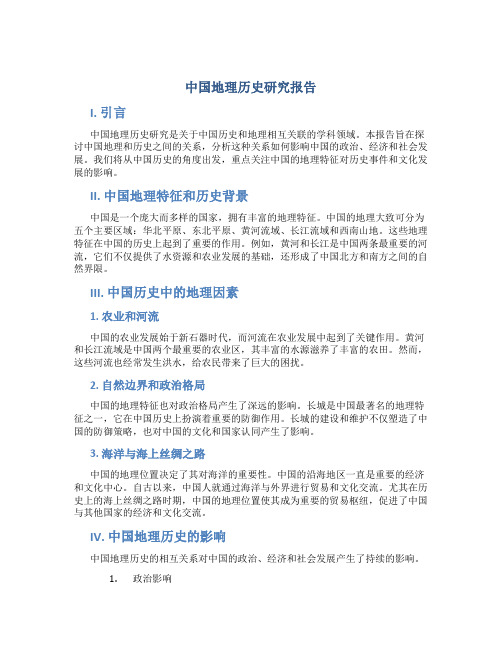
中国地理历史研究报告I. 引言中国地理历史研究是关于中国历史和地理相互关联的学科领域。
本报告旨在探讨中国地理和历史之间的关系,分析这种关系如何影响中国的政治、经济和社会发展。
我们将从中国历史的角度出发,重点关注中国的地理特征对历史事件和文化发展的影响。
II. 中国地理特征和历史背景中国是一个庞大而多样的国家,拥有丰富的地理特征。
中国的地理大致可分为五个主要区域:华北平原、东北平原、黄河流域、长江流域和西南山地。
这些地理特征在中国的历史上起到了重要的作用。
例如,黄河和长江是中国两条最重要的河流,它们不仅提供了水资源和农业发展的基础,还形成了中国北方和南方之间的自然界限。
III. 中国历史中的地理因素1. 农业和河流中国的农业发展始于新石器时代,而河流在农业发展中起到了关键作用。
黄河和长江流域是中国两个最重要的农业区,其丰富的水源滋养了丰富的农田。
然而,这些河流也经常发生洪水,给农民带来了巨大的困扰。
2. 自然边界和政治格局中国的地理特征也对政治格局产生了深远的影响。
长城是中国最著名的地理特征之一,它在中国历史上扮演着重要的防御作用。
长城的建设和维护不仅塑造了中国的防御策略,也对中国的文化和国家认同产生了影响。
3. 海洋与海上丝绸之路中国的地理位置决定了其对海洋的重要性。
中国的沿海地区一直是重要的经济和文化中心。
自古以来,中国人就通过海洋与外界进行贸易和文化交流。
尤其在历史上的海上丝绸之路时期,中国的地理位置使其成为重要的贸易枢纽,促进了中国与其他国家的经济和文化交流。
IV. 中国地理历史的影响中国地理历史的相互关系对中国的政治、经济和社会发展产生了持续的影响。
1.政治影响中国的地理特征对政治行为产生了深远的影响。
地理条件决定了中国历史上的分裂和统一。
例如,黄河和长江的存在使得中国南北之间形成了自然的界限,导致政治力量的分裂和不稳定。
然而,在中国历史上也有一些政治家利用地理特征,通过建设运河和长城等策略,实现国家的统一。
三年级社会祖国的大好河山了解中国地理和历史文化
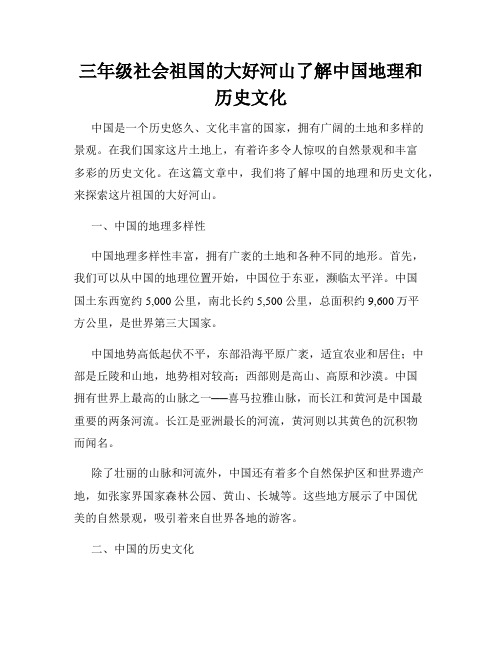
三年级社会祖国的大好河山了解中国地理和历史文化中国是一个历史悠久、文化丰富的国家,拥有广阔的土地和多样的景观。
在我们国家这片土地上,有着许多令人惊叹的自然景观和丰富多彩的历史文化。
在这篇文章中,我们将了解中国的地理和历史文化,来探索这片祖国的大好河山。
一、中国的地理多样性中国地理多样性丰富,拥有广袤的土地和各种不同的地形。
首先,我们可以从中国的地理位置开始,中国位于东亚,濒临太平洋。
中国国土东西宽约5,000公里,南北长约5,500公里,总面积约9,600万平方公里,是世界第三大国家。
中国地势高低起伏不平,东部沿海平原广袤,适宜农业和居住;中部是丘陵和山地,地势相对较高;西部则是高山、高原和沙漠。
中国拥有世界上最高的山脉之一──喜马拉雅山脉,而长江和黄河是中国最重要的两条河流。
长江是亚洲最长的河流,黄河则以其黄色的沉积物而闻名。
除了壮丽的山脉和河流外,中国还有着多个自然保护区和世界遗产地,如张家界国家森林公园、黄山、长城等。
这些地方展示了中国优美的自然景观,吸引着来自世界各地的游客。
二、中国的历史文化中国拥有悠久的历史和丰富的文化遗产,从古代到现代都有着独特的魅力。
中国文化以其传统的价值观、哲学和艺术而闻名于世。
以下是中国历史文化的一些重要方面:1. 语言和文字:中国是世界上唯一使用汉字的国家之一。
汉字是一种象形文字,已有数千年的历史。
汉字的书写方式独特而美丽,是中华民族独特的文化符号。
2. 饮食文化:中国有着丰富多样的饮食文化,每个地区都有自己独特的传统菜肴。
中国菜以其独特的调味和烹饪方式而著名,如四川川菜的麻辣口味和广东粤菜的清淡口感。
3. 传统节日:中国有许多重要的传统节日,如春节、中秋节和端午节等。
这些节日有着悠久的历史和独特的风俗习惯,代表着中国人民的传统价值观和文化传承。
4. 传统艺术:中国有着丰富多样的传统艺术形式,如京剧、曲艺、中国画等。
这些艺术形式代表着中国人民的审美观念和对艺术的热爱。
中国地理历史
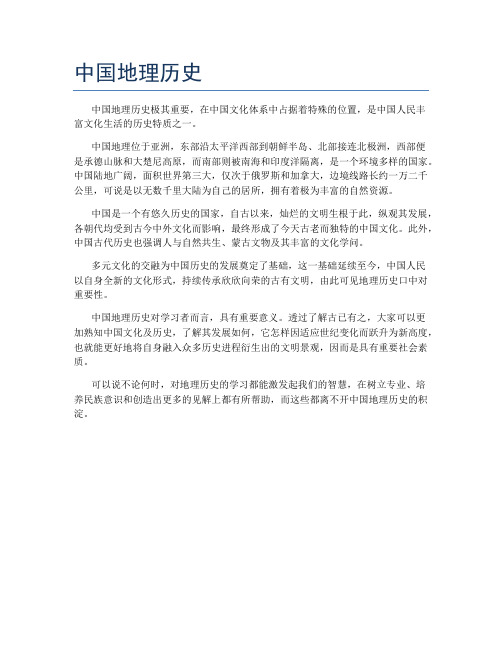
中国地理历史
中国地理历史极其重要,在中国文化体系中占据着特殊的位置,是中国人民丰
富文化生活的历史特质之一。
中国地理位于亚洲,东部沿太平洋西部到朝鲜半岛、北部接连北极洲,西部便
是承德山脉和大楚尼高原,而南部则被南海和印度洋隔离,是一个环境多样的国家。
中国陆地广阔,面积世界第三大,仅次于俄罗斯和加拿大,边境线路长约一万二千公里,可说是以无数千里大陆为自己的居所,拥有着极为丰富的自然资源。
中国是一个有悠久历史的国家,自古以来,灿烂的文明生根于此,纵观其发展,各朝代均受到古今中外文化而影响,最终形成了今天古老而独特的中国文化。
此外,中国古代历史也强调人与自然共生、蒙古文物及其丰富的文化学问。
多元文化的交融为中国历史的发展奠定了基础,这一基础延续至今,中国人民
以自身全新的文化形式,持续传承欣欣向荣的古有文明,由此可见地理历史口中对重要性。
中国地理历史对学习者而言,具有重要意义。
透过了解古已有之,大家可以更
加熟知中国文化及历史,了解其发展如何,它怎样因适应世纪变化而跃升为新高度,也就能更好地将自身融入众多历史进程衍生出的文明景观,因而是具有重要社会素质。
可以说不论何时,对地理历史的学习都能激发起我们的智慧,在树立专业、培
养民族意识和创造出更多的见解上都有所帮助,而这些都离不开中国地理历史的积淀。
中国历史相关的地理因素是什么
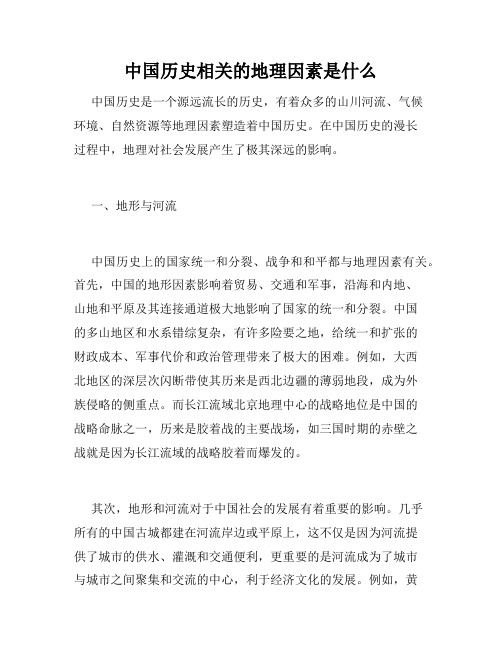
中国历史相关的地理因素是什么中国历史是一个源远流长的历史,有着众多的山川河流、气候环境、自然资源等地理因素塑造着中国历史。
在中国历史的漫长过程中,地理对社会发展产生了极其深远的影响。
一、地形与河流中国历史上的国家统一和分裂、战争和和平都与地理因素有关。
首先,中国的地形因素影响着贸易、交通和军事,沿海和内地、山地和平原及其连接通道极大地影响了国家的统一和分裂。
中国的多山地区和水系错综复杂,有许多险要之地,给统一和扩张的财政成本、军事代价和政治管理带来了极大的困难。
例如,大西北地区的深层次闪断带使其历来是西北边疆的薄弱地段,成为外族侵略的侧重点。
而长江流域北京地理中心的战略地位是中国的战略命脉之一,历来是胶着战的主要战场,如三国时期的赤壁之战就是因为长江流域的战略胶着而爆发的。
其次,地形和河流对于中国社会的发展有着重要的影响。
几乎所有的中国古城都建在河流岸边或平原上,这不仅是因为河流提供了城市的供水、灌溉和交通便利,更重要的是河流成为了城市与城市之间聚集和交流的中心,利于经济文化的发展。
例如,黄河流域的城市大都是在河岸或河滩上的,如河南洛阳、河北邢台、山东济南等,河流的交通和农业生产成为社会经济发展的支撑。
二、气候环境气候环境对于人们的生命周期、自然资源、食品产量和卫生健康等方面的影响往往被忽视,但在中国历史中却起到了至关重要的作用。
中国气候变迁较为明显,不同季节和地区都有着不同的气候,北方和南方的气候差异非常大,这种气候差异对于农业生产、人口增长、迁徙和商业往来都带来了深远影响。
例如,在苏南地区,沿海高温高湿的气候和肥沃的土壤造就了丰富的农业生产和广泛的商业贸易,天津地区的冬季寒冷防卫易,《东周列国志》中即有“咸河冰可涉,胡地易不能御,故天下归唐”一语,用以形容敌军不敢南侵中原的原因。
而与甘肃地区的干燥、寒冷和草地气候孕育了独特的民族文化和经济模式,如民族游牧、奶制品和裘皮制作。
三、自然资源中国的自然资源丰富,包括煤、铁、石油、水、森林和土地等。
中国的地理考古与历史地理
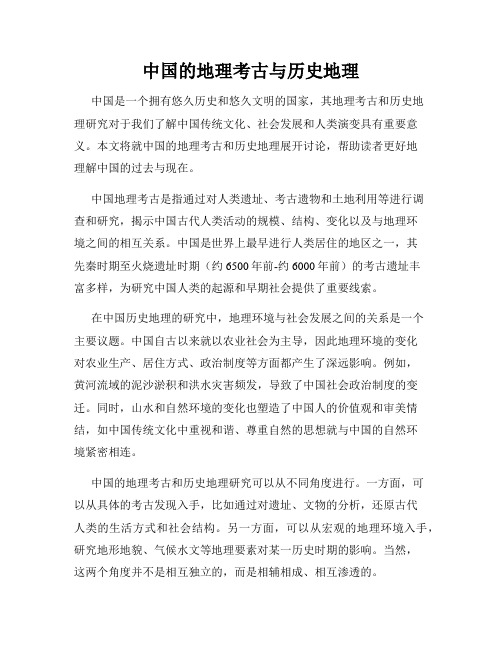
中国的地理考古与历史地理中国是一个拥有悠久历史和悠久文明的国家,其地理考古和历史地理研究对于我们了解中国传统文化、社会发展和人类演变具有重要意义。
本文将就中国的地理考古和历史地理展开讨论,帮助读者更好地理解中国的过去与现在。
中国地理考古是指通过对人类遗址、考古遗物和土地利用等进行调查和研究,揭示中国古代人类活动的规模、结构、变化以及与地理环境之间的相互关系。
中国是世界上最早进行人类居住的地区之一,其先秦时期至火烧遗址时期(约6500年前-约6000年前)的考古遗址丰富多样,为研究中国人类的起源和早期社会提供了重要线索。
在中国历史地理的研究中,地理环境与社会发展之间的关系是一个主要议题。
中国自古以来就以农业社会为主导,因此地理环境的变化对农业生产、居住方式、政治制度等方面都产生了深远影响。
例如,黄河流域的泥沙淤积和洪水灾害频发,导致了中国社会政治制度的变迁。
同时,山水和自然环境的变化也塑造了中国人的价值观和审美情结,如中国传统文化中重视和谐、尊重自然的思想就与中国的自然环境紧密相连。
中国的地理考古和历史地理研究可以从不同角度进行。
一方面,可以从具体的考古发现入手,比如通过对遗址、文物的分析,还原古代人类的生活方式和社会结构。
另一方面,可以从宏观的地理环境入手,研究地形地貌、气候水文等地理要素对某一历史时期的影响。
当然,这两个角度并不是相互独立的,而是相辅相成、相互渗透的。
地理考古和历史地理研究对于我们了解中国的过去与现在具有重要启示。
首先,它可以帮助我们更好地理解中国的传统文化和价值观。
通过研究古代人类的生活方式、社会结构和思想意识,我们可以认识到中国文化的独特性以及其对现代社会的影响。
其次,地理考古和历史地理的研究还可以为环境保护和可持续发展提供经验和启示。
通过对古代社会对地理环境的适应和利用方式进行学习,我们可以寻找现代社会的可持续发展模式。
最后,地理考古和历史地理的研究也对国家政策和规划具有参考价值。
古代历史与地理的关系与演进
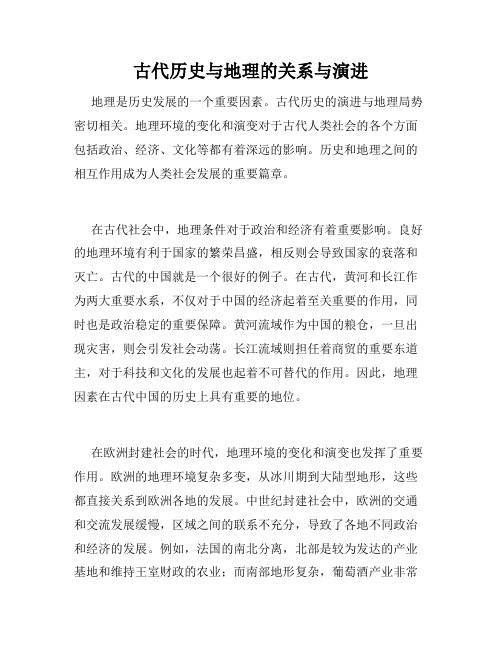
古代历史与地理的关系与演进地理是历史发展的一个重要因素。
古代历史的演进与地理局势密切相关。
地理环境的变化和演变对于古代人类社会的各个方面包括政治、经济、文化等都有着深远的影响。
历史和地理之间的相互作用成为人类社会发展的重要篇章。
在古代社会中,地理条件对于政治和经济有着重要影响。
良好的地理环境有利于国家的繁荣昌盛,相反则会导致国家的衰落和灭亡。
古代的中国就是一个很好的例子。
在古代,黄河和长江作为两大重要水系,不仅对于中国的经济起着至关重要的作用,同时也是政治稳定的重要保障。
黄河流域作为中国的粮仓,一旦出现灾害,则会引发社会动荡。
长江流域则担任着商贸的重要东道主,对于科技和文化的发展也起着不可替代的作用。
因此,地理因素在古代中国的历史上具有重要的地位。
在欧洲封建社会的时代,地理环境的变化和演变也发挥了重要作用。
欧洲的地理环境复杂多变,从冰川期到大陆型地形,这些都直接关系到欧洲各地的发展。
中世纪封建社会中,欧洲的交通和交流发展缓慢,区域之间的联系不充分,导致了各地不同政治和经济的发展。
例如,法国的南北分离,北部是较为发达的产业基地和维持王室财政的农业;而南部地形复杂,葡萄酒产业非常发达。
这些不同的发展,直接导致了欧洲社会政治和经济发展的不平衡和不一致。
在日本,地理环境也对经济和政治造成了深远影响。
日本位于环太平洋地震带,地质条件恶劣。
这就导致了日本的地震、海啸等多种自然灾害。
这些天灾地变使得日本经济不断波动和政治活动受到牵制。
然而,日本拥有得天独厚的自然资源,如木材、煤炭等,在这些资源的带动下,日本经济在19世纪前期迅速发展,成为当时的亚洲强国。
总的来说,古代历史与地理的关系与演进密不可分。
地理环境的变迁和演化往往对于古代社会的政治、经济和文化造成深远的影响,对于人类的社会演变有着至关重要的作用。
因此,在今天我们要更好地认识历史和地理之间的相互作用,来更好地理解人类社会的演变和发展趋势。
历史地理背景

历史地理背景
历史和地理背景对于理解一个国家或地区的文化和发展有着重
要的影响。
本文将介绍中国的历史地理背景,以帮助读者更好地了
解中国的发展和文化。
历史背景
中国的历史可以追溯到几千年前。
中国是一个拥有悠久历史的
文明古国,经历了许多王朝的更替和各种政治和社会转变。
在中国,农业起源和古代文明的发展对国家的形成和演变起到了重要作用。
从夏朝到商朝,再到周朝和秦朝,中国历史上出现了许多重要的政权。
随着时间的推移,中国逐渐形成了一个中央集权的国家制度,
并培养了独特的价值观和思想体系。
地理背景
中国位于东亚,东临太平洋。
中国地理上的多样性对于国家的
发展产生了深远影响。
中国拥有广袤的土地,包括丰富的山脉、平
原、河流和海洋。
这些地形特征为中国的农业、交通和资源产业提
供了独特的优势和挑战。
中国的地理位置也促进了与周边国家的交流和贸易。
中国与韩国、朝鲜、俄罗斯、蒙古、印度、越南等国家接壤,这使得中国成
为东亚地区的重要经济和政治力量。
结论
中国的历史地理背景对于国家的文化、发展和地位起到了至关
重要的作用。
通过了解中国的历史和地理特征,我们可以更好地理
解中国的发展轨迹和文化传统。
这为进一步研究和了解中国的经济、政治和社会提供了基础。
参考文献:
- 张敬轩,王志勇. (2007). 中国历史地理概论. 东北师范大学出
版社.
- 李建全,李涛. (2013). 中国历史地理释例. 吉林人民出版社.。
- 1、下载文档前请自行甄别文档内容的完整性,平台不提供额外的编辑、内容补充、找答案等附加服务。
- 2、"仅部分预览"的文档,不可在线预览部分如存在完整性等问题,可反馈申请退款(可完整预览的文档不适用该条件!)。
- 3、如文档侵犯您的权益,请联系客服反馈,我们会尽快为您处理(人工客服工作时间:9:00-18:30)。
Chinese history
Primitive men lived in China about 1.7 years ago. Historical research has produced evidence that approximately 400,000 to 500,000 years ago the famous Beijing Man could make and use simple tools and knew how to use and control fire.
The Xia dynasty (21st—16th centuries BC) saw the first introduction in Chinese history of the slave system. In the dynasties after the Xia, that is the Shang (16th---11th centuries BC) and the Western Zhou (11th century to 770 BC), a slave society was firmly established. Then came the transitional phase from slave to feudal society in the Spring and Autumn Period(770 –476BC), when the princely rival states were fighting for supremacy. The state of Qin unified China in 221 BC, and established the first centralized, multi-national feudal state. In the 2000 years that followed, peasant uprisings brought about the rise and fall of dynasty after dynasty. The cycle of China’s feudal society began to decay in the Ming and mid-Qing dynasties(1368--1840). In short, up to the Opium War in 1840, for more than 2000 years China remained a feudal society.
The history of modern China begins with the Opium War in 1840. Subsequent invasions by the imperialist powers gradually reduce china to the status of a semi-colonial and semi-feudal
country. The Chinese people began a long and courageous struggle against the oppression of feudalism and foreign aggression. The 1911 Revolution overthrew the Qing dynasty and ended the autocratic feudal rule, but failed to liberate China from the heavy burdens of imperialism, feudalism and bureaucratic capitalism that weighed down on the people’s shoulders. The Chinese Communist Party was founded in 1921, and finally led the people to victory with the founding of the People’s Republic of China on Oc tober 1, 1949. The coming of socialism has transformed the face of ancient China and turned over a new page in the long history.
Geography of China
The People’s Republic of China lies in East Asia on the western Pacific coast. Its area of 96 million square kilometers is almost as large as the entire European continent. The national inland boundaries total over 20,000 kilometers, with over 18,000 kilometers of coastline. There are more than 5,000 islands in its vast territorial waters, the largest bing Taiwan and the second largest, Hainan. In the extreme south are the South China Sea Islands.
The land descends from the west to the east like a flight of
stairs. The highest step is the Qinghai-Tibet Plateau, which averages over 4000 meters above sea level. T he world’s highest peak, Mt. Qomolangma, towers over the China—Nepal border at 8,848 meters. East of the Plateau the topography suddenly drops to 1000—2000 meters. This second step is characterized by highlands alternating with basins. The third step stretches right down to the sea coast, with hills and plains averaging 500 meters above sea level. Still further east lies the continental shelf.
China’s geography is extremely varied and complex, including mountains, plateaus, plains, grasslands, basins, hills, islands, desert, glaciers, and frozen earth. Mountain areas cover about two-thirds of the total land area. There are more than 1500 large rivers, the principal ones being the Changjiang (Yangzi River 6300 kilometers), the Huanghe (Yellow Revier 5464 kilometers), the Heilongjiang River and the Zhujiang River. China has 370 large lakes, of which the chief fresh-water lakes are Boyang, Dongting, Hongze and Taihu. Lake Qinghai is the largest salt-water lake.
The climate is varied, ranging from sub-arctic to temperate to tropical. However, the greater part of China is in the temperate zone, with four clearly-defined seasons.。
